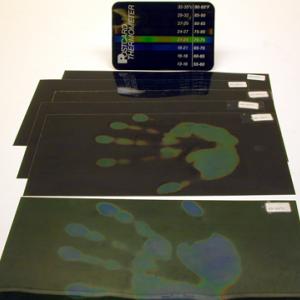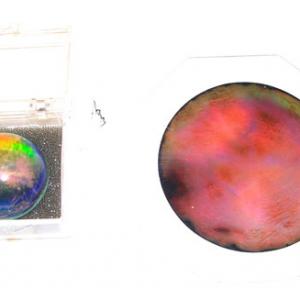College of Liberal Arts & Sciences
4A10.50 - Liquid Crystals
See also 1R50.30 in Mechanics and 6H35.62 in Optics.
Pick out a liquid crystal sheet in the temperature range that you wish to use it. For use with the fingers and hands you will need the liquid crystals that operate below 35 degrees centigrade.
You can also use the liquid crystal sheets as heat flow indicators by gluing them onto pieces of metal or plastic.
You can also focus a Maglite onto one of the sheets of liquid crystal and see the color change where the heat from the flashlight strikes the crystal.
- Jukka O, Mattila, "Laptop Art", TPT, Vol. 34, #2, Feb. 1996, p. 78.
- Thomas M. Ciferno, Renate J. Ondris-Crawford, Gregory P. Crawford, "Inexpensive Electrooptic Experiments on Liquid Crystal Displays", TPT, Vol. 33, #2, Feb. 1995, p. 104.
- Renate Ondris-Crawford, Gregory P. Crawford, and J. William Doane, "The Phase of the Future", TPT, Vol. 30, #6, Sept. 1992, p. 332.
- "Liquid Crystal Displays: Watches, Calculators and (soon) Cars", TPT, Vol. 21, #7, Oct. 1983, p. 467.
- Anthony J. Nicastro, "Demonstrations of Some Optical Properties of Liquid Crystals", TPT, Vol. 21, #3, Mar. 1983, p. 181.
- Carl H. Hayn, "Liquid Crystal Displays", TPT, Vol. 19, #4, Apr. 1981, p. 256.
- Mark Handschy, "More on Liquid Crystals", TPT, Vol. 19, #6, Sept. 1981, p. 362.
- P. Andrew Penz, "Hydro-Optic Effects in Liquid Crystals", TPT, Vol. 13, #4, Apr. 1975, p. 199.
- Gordon L. Johnson, "Sorry, Our Mistake", TPT, Vol. 13, #7, Oct.. 1975, p. 448.
- Thomas Moses, Brian Durall, Gregory Frankowiak, "Magnetic Birefringence in a Liquid Crystal: An Experiment for the Advanced Undergraduate Laboratory", AJP, Vol. 68, #3, Mar. 2000, p. 248.
- Peter J. Collings, "Liquid Crystal Displays", AJP, Vol. 63, #11, Nov. 1995, p. 1044.
- Renate J. Ondris-Crawford, Gregory P. Crawford, and J. William Doane, "Resource Letter: LC-1: Liquid Crystals: Physics and Applications", AJP, Vol. 63, #9, Sep. 1995, p. 781.
- E. F. Carr and J. P. McClymer, "A Laboratory Experiment on Interference of Polarized Light Using a Liquid Crystal", AJP, Vol. 59, #4, Apr. 1991, p. 366.
- James L. Fergason, "Experiments with Cholesteric Liquid Crystals", AJP, Vol. 38, #4, Apr. 1970, p. 425.
- Myron A. Jeppesen and William T. Hughes, "Liquid Crystals and Newton's Rings", AJP, Vol. 38, #2, Feb. 1970, p. 199.
- Qing Zhang, Irmgard Bischofberger, "Twisted Liquid Crystal", Physics Today, Vol. 77, #2, Feb. 2024, p. 64.
- Richard J. Fitzgerald, "The Nature and Art of Liquid Crystals", Physics Today, Vol. 71, #10, Oct. 2018, p. 76.
- "Graphene Visualized", Physics Today, Vol. 70, #4, Apr. 2017, p. 72.
- Peter Palffy-Muhoray, "The Diverse World of Liquid Crystals", Physics Today, Sept. 2007, p. 54.
- H-018: Liquid Xtal-Galileo's Thermom.", DICK and RAE Physics Demo Notebook.
- T. Kallard, "Optics Experiments with Liquid Crystals", Exploring Laser Light, p. 101.
- Borislaw Bilash II, “Liquid Crystals“, A Demo A Day – A Year of Physical Science Demonstrations, p. 105.
Disclaimer: These demonstrations are provided only for illustrative use by persons affiliated with The University of Iowa and only under the direction of a trained instructor or physicist. The University of Iowa is not responsible for demonstrations performed by those using their own equipment or who choose to use this reference material for their own purpose. The demonstrations included here are within the public domain and can be found in materials contained in libraries, bookstores, and through electronic sources. Performing all or any portion of any of these demonstrations, with or without revisions not depicted here entails inherent risks. These risks include, without limitation, bodily injury (and possibly death), including risks to health that may be temporary or permanent and that may exacerbate a pre-existing medical condition; and property loss or damage. Anyone performing any part of these demonstrations, even with revisions, knowingly and voluntarily assumes all risks associated with them.

